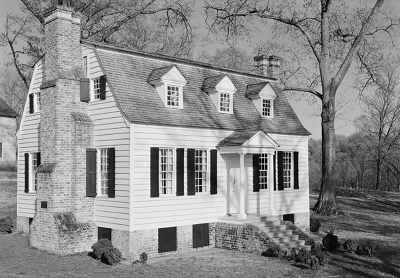Hanover Plantation – Lake Moultrie – Berkeley County

— Hanover Plantation 1939 © Library of Congress —
(Prints & Photographs Division HABS SC,8-PINOP.V,12-)
Note: The house at Hanover was also called the St. Julien-Ravenel House. It was moved to Pickens County to protect it from flooding by Santee Cooper.
Basic Information
- Location – Submerged under Lake Moultrie, St. John's Berkeley Parish, Pinopolis, Berkeley County
- Origin of name – It is thought that the house was named for the House of Hanover which had come to the British throne and had been kind to Huguenot refugees (1, p. 3) (6, p. 73).
- Other names – St. Julien-Ravenel House
- Current status – In 1939, work began on the Santee Cooper Hydroelectric and Navigation Project. This project displaced many families and communities, and many historic homes were lost as the area was flooded.
The house was dismantled and relocated to Clemson University in the 1940s.

— Hanover Plantation House After Moved and Restored, Circa 1940s —
— © Library of Congress —
(Prints & Photographs Division HABS SC,8-PINOP.V,12-)
Timeline
-
There are two theories on the early founding of the plantation.
- 1688 – Earliest known date of existence (1, p. 3)
Paul de St. Julien's grandfather was granted three 1,000-acre land grants from the Lord Proprietors (1, p. 3).
THEORY TWO: - ? – Earliest known date of existence (6, p. 73)
Daniel Couturiere acquired the property (6, p. 73)
- ? – Paul de St. Julien's 1741 will noted that he had purchased Hanover from Daniel Couturiere (6, p. 73).
- 1714-1716 – House built (1, p. 2)
Paul de St. Julien built a one-and-one-half story cypress house at the plantation (1, 2) (6, p. 73).
- Late 1700s – Henry Ravenel owned Hanover Plantation (6, p. 221).
- 1741 – In his will, Paul de St. Julien left Hanover to his wife Mary until their daughter, also called Mary, became of age or was married (6, p. 73).
- ? – The daughter, Mary de St. Julien, married Henry Ravenel and did inherit Hanover Plantation (2).
- 1941 – House relocated to Clemson University due to area being flooded as part of the Santee Cooper Hydroelectric and Navigation Project. The house has was also restored (1) (6, p. 74).
THEORY ONE:
Land
- Number of acres – 1,000 in 1714 (1, p. 3)
- Primary crop – Santee long cotton (hybrid between Upland cotton and Sea Island cotton)
Slaves
- Number of slaves – ?
References & Resources
- National Register of Historic Places
– Nomination form - PDF - submitted in 1970
– Photographs, architectural overview
- The Hanover House: Click here
- 30-15 Plantation File, held by the South Carolina Historical Society
- William P. Baldwin Jr., Plantations of the Low Country
(Westbrook, ME: Legacy Publishing, 1994)
- Claude Henry Neuffer, editor, Names in South Carolina, Volume I through 30 (Columbia, SC: The State Printing Company)
 Order Names in South Carolina, Volumes I-XII, 1954-1965
Order Names in South Carolina, Volumes I-XII, 1954-1965
 Order Names in South Carolina, Index XIII-XVIII
Order Names in South Carolina, Index XIII-XVIII
- J. Russell Cross, Historic Ramblin's through Berkeley
(Columbia, SC: R.L. Bryan Company, 1985)
 Order Historic Ramblin's through Berkeley
Order Historic Ramblin's through Berkeley - Waterman Report of 1939
- Library of Congress:
– Drawings of the house
– Pictures of the house
- Henry Edmund Ravenel, Ravenel Records - large PDF file - (Atlanta, GA: The Franklin Printing and Publishing Co., 1898) - Library of Congress
Contact Information
- South Carolina Botanical Garden
102 Garden Trail
Clemson University
Clemson, SC 29634
Telephone: 864-656-3405
Website: Click here


